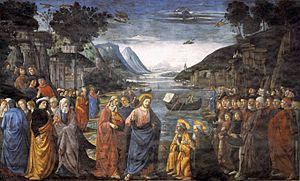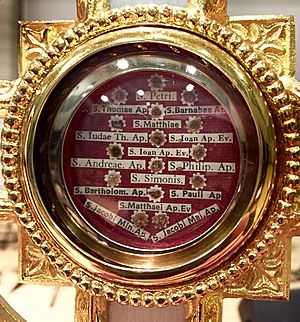Twelve Apostles facts for kids

The Twelve Apostles were a special group of men chosen by Jesus Christ. The word "apostle" means "someone sent out" or "someone on a mission." According to Christian tradition, these men were chosen from among Jesus's many students (called disciples).
The Gospel of Mark says that Jesus first sent these twelve apostles out in pairs. They traveled to different towns in Galilee to share his message.
Contents
Who Were the Twelve Apostles?
The Bible's Synoptic Gospels (Mark, Matthew, and Luke) all list the twelve men Jesus chose early in his work. He even called them "Apostles." Here are their names:
- Simon: Jesus called him Peter, which means "rock." He was a fisherman from Bethsaida and was Andrew's brother.
- Andrew: Peter's brother. He was also a fisherman and was one of the first apostles Jesus called.
- James: John's brother and son of Zebedee. Jesus called him "Son of Thunder."
- John: James's brother and son of Zebedee. He was also called "Son of Thunder." John is known as the only apostle who was not killed for his faith. He also wrote one of the Gospels in the New Testament.
- Philip: He was from Bethsaida in Galilee.
- Thaddeus: Also known as "Judas, son of James."
- Bartholomew: His name might mean "son of Talemai." Some people think he is the same person as Nathanael.
- Thomas: Also known as "Didymus," which means "twin."
- James: Often called "James the Less." He was the son of Alphaeus.
- Matthew: He was a tax collector. Some believe he is the same person as Levi, son of Alphaeus. Matthew wrote the Gospel of Matthew.
- Simon the Canaanite: In Luke and Acts, he is called "Simon the Zealot."
- Judas Iscariot: He was the apostle who betrayed Jesus. Later, he was replaced by Saint Matthias.
It's important to know that while the "Twelve Apostles" were Jesus's first close followers, Paul (who used to be called Saul of Tarsus) is also considered an important apostle. The first twelve apostles were mainly sent to Jewish people. Paul, however, had a special role as the apostle to the non-Jewish people (Gentiles) after Jesus came back to life.
The name of one of the twelve apostles, traditionally known as St. Jude, can be a bit confusing. Different Bible writings and old copies of the Gospels use different names for him:
- Mark calls him Thaddaeus.
- Some copies of Matthew also call him Thaddaeus or Lebbaeus.
- Luke calls him Judas, son of James.
The Gospel of John does not give a full list of the apostles like the other Gospels. However, it does mention "the Twelve" and names nine of them:
- Peter
- Andrew (Peter's brother)
- The sons of Zebedee (this means at least two apostles, likely James and John)
- Philip
- Thomas (also called Didymus)
- Judas Iscariot
- Judas (but not Iscariot)
Many people believe that Nathanael, mentioned in John's Gospel, is the same person as Bartholomew. Also, "Judas (not Iscariot)" is probably Thaddaeus (St. Jude). The Gospel of John does not clearly mention James, son of Alphaeus, Matthew, or Simon the Canaanite/Zealot.
Where Are the Apostles Buried?
Many churches around the world claim to have relics (special objects, often bones) of the apostles. Here are some of the places where they are believed to be buried:
- Andrew: Buried in the Cathedral of Saint Andrew in Patras, Greece.
- Bartholomew: Buried in the Basilica of Benevento, Italy, or the Basilica of St. Bartholomew on the Island in Rome, Italy.
- James the Great: Buried in the Santiago de Compostela Cathedral in Santiago de Compostela, Spain.
- James, son of Alphaeus: Buried in the Cathedral of St. James in Jerusalem or the Church of the Holy Apostles in Rome.
- John: No relics have been found. When his tomb was opened, there were no bones. This led to the belief that his body was taken up into heaven.
- Judas Iscariot: Buried at Akeldama near Jerusalem.
- Jude Thaddeus: Buried in St. Peter's Basilica in Rome with St. Simon the Zealot. Some of his relics are also in Chicago, USA, and in cathedrals in Reims and Toulouse, France.
- Matthew: Buried in the Salerno Cathedral, Italy.
- Matthias: Buried in St. Matthias' Abbey in Trier, Germany.
- Paul: His relics are in the Basilica of Saint Paul Outside the Walls in Rome. His skull is in the Archbasilica of Saint John Lateran with St. Peter's skull.
- Peter: Buried in St. Peter's Basilica in Vatican City, Rome, Italy. His skull is in the Archbasilica of Saint John Lateran with St. Paul's skull.
- Philip: Buried in the Church of the Holy Apostles in Rome or possibly Hierapolis, Turkey.
- Simon the Zealot: Buried in St. Peter's Basilica in Rome with St. Jude.
- Thomas: Buried in the San Thome Basilica in Chennai, India, or the Basilica of St. Thomas the Apostle in Ortona, Italy.
The Apostles' Lasting Impact
By the 2nd century AD, being connected to the apostles was seen as very important for authority. Churches believed to have been started by one of the apostles are called apostolic sees.
Paul's letters (epistles) became part of the Bible. Two of the four main Gospels were also linked to apostles. Many other Christian writings were said to be from the apostles. The Apostles' Creed, a popular statement of Christian belief, was even thought to have been written by the apostles themselves.
Christian bishops often trace their leadership back to individual apostles. It is believed that the apostles spread out from Jerusalem and started churches in many different places.
Early Christian leaders, like Pope Clement I, who were connected to apostles (like St. Peter), are called Apostolic Fathers.
Images for kids
-
Jesus and the Twelve Apostles in Domus Galilaeae, Israel.
See also
 In Spanish: Apóstoles en el Nuevo Testamento para niños
In Spanish: Apóstoles en el Nuevo Testamento para niños
- Apostle (Latter Day Saints)
- Apostles' Fast
- Companions of the Prophet
- Council of Jerusalem
- Council of Twelve Apostles
- Equal-to-apostles
- Quorum of the Twelve
- Quorum of the Twelve Apostles (LDS Church)






